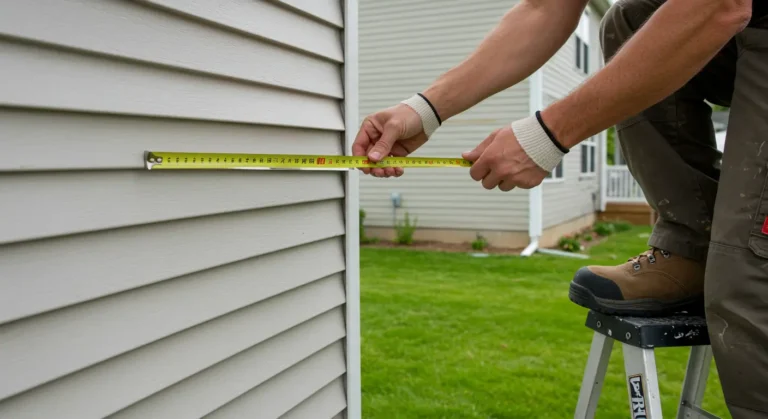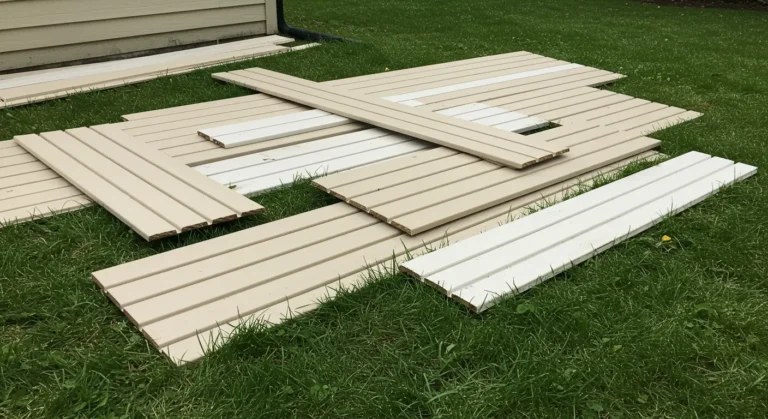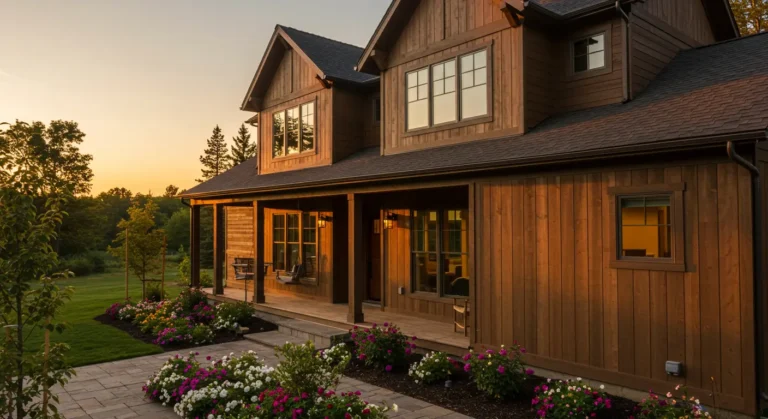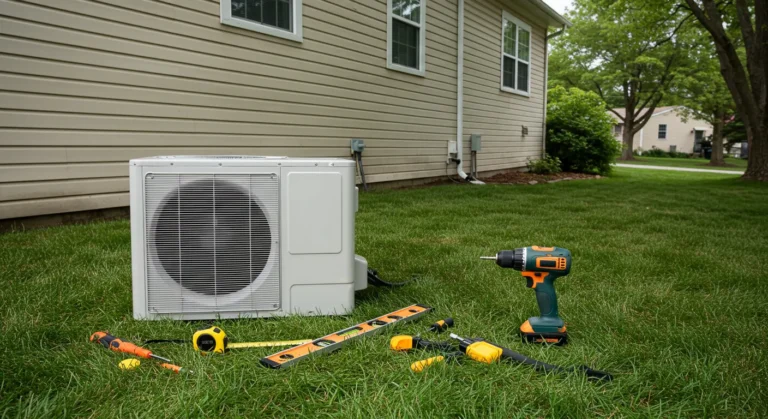Clapboard siding is one of the oldest and most enduring exterior cladding styles in American home design. Known for its overlapping horizontal layout and wood-like charm, it brings a timeless look to homes, from cozy cottages to stately colonials.
But what is clapboard siding, exactly? Why has it remained so popular for generations? And how do you know if it’s the right choice for your home?
In this guide, we’ll explore everything homeowners need to know: from its definition and materials to how it compares to modern alternatives like vinyl and fiber cement.
What Is Clapboard Siding?
Clapboard siding refers to a siding style made from long boards installed horizontally, with each board overlapping the one below it. This overlap helps shed water and protect the home from rain, wind, and sun damage.
A Brief History
Clapboard siding has been used in North America since the 17th century. Originally hand-split from hardwood logs, the boards were shaped and nailed onto timber-framed homes. Over time, as sawmill technology advanced, smoother and more uniform boards became standard.
Today, clapboard siding remains popular in traditional home styles, particularly Cape Cod, Colonial Revival, and Farmhouse architecture. But thanks to modern materials, it’s now accessible to a wider variety of homeowners.
Clapboard siding definition: A traditional siding method involving overlapping horizontal boards, typically made of wood or wood-like materials, used for both aesthetic and protective purposes.
How Clapboard Siding Works
Each clapboard board is tapered thicker at the bottom and thinner at the top. This allows it to lay flush against the wall while overlapping the board below.
This design:
- Prevents water infiltration
- Creates distinct shadow lines that enhance curb appeal
- Offers a seamless and layered exterior texture
The boards can be installed with different exposures (the visible portion of each board), depending on the look you want. Narrow exposures feel more traditional, while wider ones feel more contemporary.
Materials Used in Clapboard Siding
Clapboard siding has evolved well beyond just wood. Here’s a breakdown of the most common materials available today:
1. Wood Clapboard Siding
This is the original material. Cedar and pine are most commonly used due to their resistance to decay and insects. It can be painted, stained, or left to weather naturally for a rustic look.
- Pros: Authentic look, customizable finishes, natural insulation
- Cons: Requires regular maintenance (painting, sealing), higher cost
2. Engineered Wood
Made from compressed wood fibers and resins, engineered wood mimics natural wood but resists moisture and warping better.
- Pros: More affordable than natural wood, less prone to pests or rot
- Cons: Still needs repainting every few years
3. Vinyl Clapboard
Vinyl is made from polyvinyl chloride (PVC) and molded to imitate wood grain.
- Pros: Low maintenance, affordable, resistant to weather
- Cons: Can fade, crack in extreme cold, and lacks the authentic texture of real wood
4. Fiber Cement
This heavy-duty material is made from cement, sand, and cellulose fibers. It holds paint well and mimics the grain of wood.
- Pros: Fire-resistant, insect-resistant, long-lasting
- Cons: Heavier and harder to install, can be costly
Want to see how these materials are used in the real world? Check out this comprehensive overview of clapboard siding installation and benefits.
Pros and Cons of Clapboard Siding
Here’s an honest look at why clapboard siding continues to win over homeowners and where it might fall short:
Pros
- Timeless Appeal: Enhances historic and modern homes alike.
- Versatile Materials: Choose from real wood, vinyl, engineered wood, or fiber cement.
- Customizable Finish: Can be painted or stained to match any design.
- Home Value: Improves curb appeal and resale potential.
- Natural Insulation (Wood): Offers modest energy efficiency benefits.
Cons
- Maintenance: Wood options need repainting or sealing every 5-10 years.
- Installation Cost: More complex installation than vertical siding.
- Weather Sensitivity: In wet or humid climates, untreated wood can be vulnerable to rot.
- Damage Risk: Cracking, peeling, or warping may occur if maintenance is neglected.
Clapboard vs. Other Siding Styles
Clapboard vs Vinyl Siding
While vinyl mimics clapboard, it’s made of plastic. It’s more affordable and low maintenance, but can’t match the depth and feel of real wood. Vinyl may also fade or crack over time.
Clapboard vs Lap Siding
Clapboard is a form of lap siding. “Lap” simply means overlapping boards. Clapboard is the most basic form, while Dutch lap or beaded lap have more decorative profiles.
Clapboard vs Board and Batten
Board and batten is installed vertically with battens (narrow strips) covering the seams between wide boards. It’s great for a farmhouse look, while clapboard offers a more classic horizontal design.
Want to explore more exterior siding options? Visit our siding installation services page.
How to Install Clapboard Siding (Overview)
Clapboard installation isn’t necessarily a beginner-friendly DIY, but knowing the process helps you understand what to expect.
Tools Needed:
- Hammer or nail gun
- Chalk line
- Level
- Circular saw
- Starter strips and flashing
- Exterior-rated nails
Basic Steps:
- Prep the Surface: Install sheathing and house wrap for weatherproofing.
- Start at the Bottom: Secure a starter strip to guide the first row.
- Layer Boards Upward: Each board overlaps the one below it.
- Use flashing at Joints: Prevent moisture intrusion at seams.
- Install Trim and Paint/Stain: Finalize the aesthetic.
While DIYers can take this on with care, it’s usually best to trust experienced professionals. Learn more about our siding repair options.
Maintenance and Lifespan
How long does clapboard siding last? That depends on your material:
- Wood: 30-50 years with good maintenance
- Engineered wood: 20-30 years
- Vinyl: 30-50 years
- Fiber cement: 50+ years
Signs of Wear:
- Faded or peeling paint
- Warping or cupping boards
- Rot or insect damage (wood)
- Cracks or gaps (vinyl)
Maintenance Tips:
- Inspect yearly for damage
- Clean with a mild detergent and hose or pressure washer
- Repaint wood every 5-10 years
- Reseal caulking around windows and doors
Check out these tips for repairing damaged wood clapboard.
Cost and Long-Term Value
The cost of clapboard siding can vary widely based on materials and labor.
Average Costs (Installed):
| Material | Per Sq. Ft. (Installed) |
| Wood | $7-$12 |
| Engineered Wood | $5-$8 |
| Vinyl | $3-$7 |
| Fiber Cement | $6-$10 |
ROI:
According to Remodeling Magazine’s Cost vs. Value report, siding replacement can recoup up to 80% of the cost at resale, especially if it improves curb appeal with a high-quality material like clapboard.
Is Clapboard Siding Right for Your Home?
Clapboard works beautifully on a wide range of homes. It’s especially ideal for:
- Historic or Colonial-style homes
- Cottages or Farmhouses
- Homes in dry to moderate climates
- Homeowners who prioritize aesthetics over minimal maintenance
Story Spotlight:
A homeowner in New Orleans wanted to preserve the look of their 1920s bungalow. They replaced their damaged vinyl with painted cedar clapboard. The result? A stunning transformation that honored the home’s original charm while improving energy efficiency and resale value.
Not sure if it’s right for your climate or architecture? Book a Free Siding Inspection Today and let our team walk you through the best options.
Conclusion: Classic Style That Lasts
Clapboard siding offers unmatched character, flexible design options, and proven durability when properly maintained. Whether you’re restoring a historic home or refreshing your exterior, it’s worth considering this classic siding style.
Need help getting started? Lone Wolf Siding provides expert advice and siding installation services across Louisiana. Ready to take the next step? Book a Free Siding Inspection Today.
FAQs About Clapboard Siding
What does clapboard siding mean?
It’s a type of exterior siding made from long, overlapping horizontal boards. The overlap helps shed water and adds a layered, textured look to the home’s exterior.
Is clapboard siding always made of wood?
No. While traditionally made from wood, modern clapboard siding is also available in vinyl, engineered wood, and fiber cement options.
How long does clapboard siding last?
With proper maintenance, wood clapboard can last 30-50 years. Vinyl and fiber cement can last even longer, up to 50+ years.
Can you paint clapboard siding?
Yes. Wood clapboard can be painted or stained every 5-10 years. Some vinyl options can also be painted with special formulas.
Is it better than vinyl siding?
It depends on your priorities. Clapboard has a more authentic look and customizable finish. Vinyl is lower maintenance and more affordable, but it can look less natural over time.




